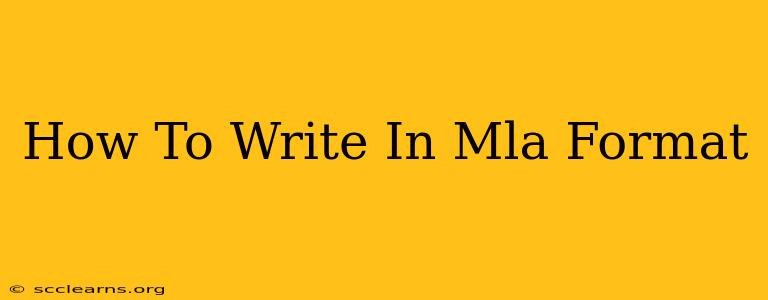Writing a research paper can be daunting, but mastering MLA format is a crucial step in ensuring your academic work is credible and well-presented. This guide provides a comprehensive overview of MLA formatting, covering everything from in-text citations to the Works Cited page. By following these guidelines, you'll confidently present your research and avoid common formatting pitfalls.
Understanding MLA Format: The Basics
The Modern Language Association (MLA) style is widely used in humanities disciplines, including literature, languages, and cultural studies. Its core principles emphasize clarity, consistency, and proper attribution of sources to avoid plagiarism. Key components of MLA format include:
- Font: Times New Roman, 12-point.
- Margins: 1-inch margins on all sides.
- Spacing: Double-spaced throughout the entire paper.
- Heading: Your name, instructor's name, course name, and date (all left-aligned).
- Page Numbers: In the upper right-hand corner of each page, including the first.
In-Text Citations: Giving Credit Where It's Due
Properly citing sources within your text is paramount. MLA uses a parenthetical citation system, typically including the author's last name and page number(s). For example:
- "Shakespeare's use of iambic pentameter is highly effective" (Shakespeare 12).
Variations in In-Text Citations:
- Multiple Authors: (Smith and Jones 15). For three or more authors, use the first author's last name followed by "et al." (Smith et al. 20).
- No Author: Use a shortened version of the title in quotation marks ( "The Impact of Social Media" 42).
- Indirect Source: If you are citing a source quoted in another source, indicate this by using "qtd. in" (Jones qtd. in Smith 10).
- Multiple Works by the Same Author: Include a shortened title to distinguish between works (Smith, Hamlet 25; Smith, Othello 18).
Mastering the Art of Paraphrasing and Quoting
While in-text citations are vital, correctly integrating quoted and paraphrased material is equally important.
- Quoting: Use quotation marks for direct quotations and cite the source. Long quotations (four lines or more) should be block-quoted.
- Paraphrasing: Restate information in your own words, but always cite the original source. Changing a few words isn't sufficient; you must significantly alter the sentence structure and wording.
The Works Cited Page: Your Source Guide
The Works Cited page, located at the end of your paper, provides a comprehensive list of every source you cited. Each entry must follow a specific format.
Example Entries:
- Book:
- Lastname, Firstname. Title of Book. Publisher, Year.
- Journal Article:
- Lastname, Firstname. "Title of Article." Title of Journal, vol. number, no. number, year, pages.
- Website:
- "Title of Page." Name of Website, date of publication or last update, URL.
Consistency is Key: Maintaining Format Throughout
Maintaining a consistent format throughout your paper is essential. Pay close attention to details like spacing, font, and indentation to create a polished and professional presentation. Using a word processor's built-in citation management tools can assist in ensuring consistency and accuracy.
Avoiding Common MLA Mistakes
- Incorrect Citations: Double-check all your in-text citations and ensure they accurately match the entries in your Works Cited page.
- Missing Entries: Make sure all cited sources appear in your Works Cited page, and vice versa.
- Inconsistent Formatting: Pay careful attention to spacing, font size, and indentation throughout the document.
Beyond the Basics: Advanced MLA Considerations
- Visual Materials: Images, graphs, and tables require proper labeling and citation.
- Electronic Sources: Specific formatting rules apply to various electronic sources, including e-books, online journals, and websites.
- Multiple Works by the Same Author: Use shortened titles to distinguish between different works by the same author.
By following these guidelines and paying close attention to detail, you can master MLA format and effectively present your research. Remember, properly formatted papers demonstrate your commitment to academic integrity and enhance the credibility of your work.

